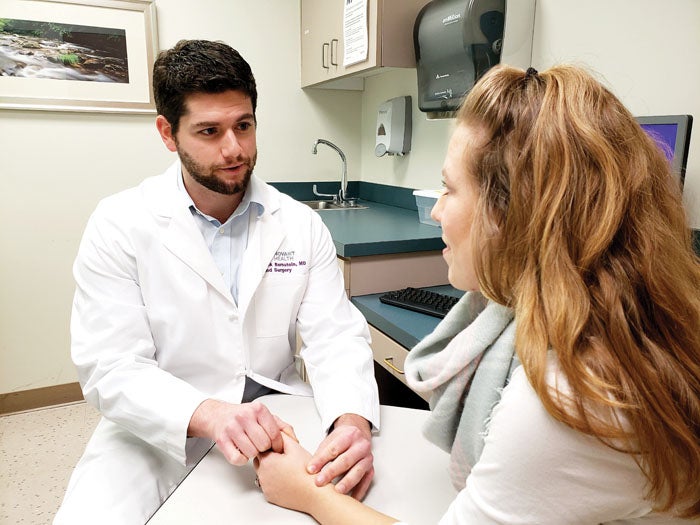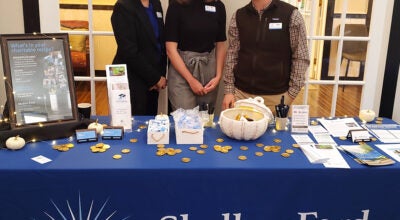Wide-awake hand surgery is as convenient as going to the dentist
Published 12:00 am Thursday, March 5, 2020

- Dr. Derek Bernstein and patient
|
Getting your Trinity Audio player ready...
|
Learn how it can result in better outcomes and save the patient money
By Josh Jarman
Novant Health
Wife: Honey, can you pick up our dry cleaning tomorrow?
Husband: Sure! Right after I drop the kids off and have my hand surgery in the morning.
Far-fetched? Not really. Dr. Derek Bernstein, an orthopedic surgeon at Novant Health Orthopedics & Sports Medicine in Clemmons, said wide-awake hand surgery is now just as easy as going to the dentist — and possibly more enjoyable. In fact, a large number of the most commonly performed hand surgeries can now be safely performed sedation-free.
Need convincing? Bernstein is here to demystify the process.
Humble beginnings
Hand surgery has come a long way since World War II. Born out of necessity, military hand centers were established to care for the wounded. These military surgeons would go on to create the subspecialty of orthopedic hand surgery and become the charter members of the American Society for Surgery of the Hand.
Over the years, hand surgery has evolved from a hospital-based surgery with anesthesia to allow for simple clinic-based procedure where the patient remains awake.
Bernstein jokes that the most challenging part about wide-awake hand surgery for the patient can be if he or she has to scratch their nose or sneeze during the procedure. The solution: Use the hand not getting operated on.
“Most patients are open to the idea of wide-awake hand surgery,” said Bernstein. “But for those patients who are a bit nervous, I try to reassure them that the experience is similar to going to the dentist.”
How it works
The patient lies down on a bed and receives an initial needle stick of lidocaine to numb the hand.
“This is a similar numbing agent dentists have used for years before operating in someone’s mouth,” said Bernstein. “While we wait for the numbing medication to work, I’ll often ask the patient to pick what type of music they would like to have on in the background.”
In the clinic setting, Bernstein can perform a wide variety of surgical procedures, including the removal of masses in the hand or fingers, tenolysis or trigger finger release (a condition that causes pain or locking sensation), carpal tunnel surgery, and even some traumatic cases where the hand or finger has been cut to the tendon.
Best practice
“There are a number of advantages to undergoing wide-awake hand surgery,” Bernstein said. “For one, being able to ask the patient to provide real-time feedback can be critically important.”
For example, Bernstein may ask a trigger finger patient to flex and extend their finger to ensure a full range of motion without catching. This allows him to correct any issues in the middle of the procedure.
“This is also a more cost-effective delivery of medicine,” said Bernstein. “The patient avoids the cost of an anesthesiologist, and when performed in the clinic, also avoids the additional cost of a facility fee.”
The patient also benefits from not having to fast before the procedure, and they experience no grogginess afterward.
Risks
Bernstein said that his only concern with wide-awake hand surgery is keeping the patient calm.
“The numbing agent we use has epinephrine in it to help control bleeding,” he said. “Epinephrine, also known as adrenaline, can make the patient feel like they just chugged a cup of coffee. That mixed with a little anxiety can be problematic.”
For those patients, Bernstein recommends deep breathing, soothing music and casual conversation about their weekend plans.
“I have never had to stop a procedure because of nerves,” he said. “And afterward, patients usually say that it wasn’t as bad as they thought.”
When should you see a hand specialist?
Bernstein said that if you have any sort of hand or upper extremity issue that is negatively affecting you on a daily basis and or preventing you from doing the things you want to do, then it is time to schedule a consultation.
“Surgery is always a last resort,” he said. “A lot of what we do in terms of treatment is considered to be non-operative. During the consultation, we can determine whether hand therapy, braces, injections or surgery is needed.”



